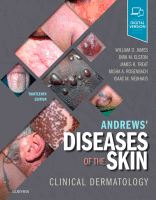Physical Address
304 North Cardinal St.
Dorchester Center, MA 02124

Epidermal Nevi Epidermal nevi are hamartomatous growths of the epidermis that are present at birth in about half of patients or develop early in childhood. The term epidermal nevus includes several entities, including keratinocytic epidermal nevi, nevus sebaceus, and nevus…

In this chapter proliferations derived from vascular endothelial cells, fibroblasts, myofibroblasts, smooth muscle cells, Schwann cells, and lipocytes are reviewed. Also discussed are several neoplasms of cells invading or aberrantly present in the dermis, such as metastatic cancer, endometriosis, and…

The genetic basis for common diseases such as atopic dermatitis and psoriasis, in addition to rare diseases, has been partially elucidated. Some genetic disorders are explained by mutations in a specific gene or genes that lead to a specific clinical…

Amyloidosis Amyloid is a material deposited in the skin and other organs that is eosinophilic, homogeneous, and hyaline in appearance. It represents beta-pleated sheet forms of various host-synthesized molecules processed into this configuration by host cells. Amyloidosis can be classified…

Collagen Many types of collagen have been identified in tissues of vertebrates ( Table 25.1 ). Collagens help form the support structure and scaffolding for many parts of the body, including tissues, blood vessels, and bones. Fibrillar collagens (types I,…

The skin interacts with the endocrine system in many ways. Some of these are discussed in this chapter. Leventhal JS, et al: Skin manifestations of endocrine and neuroendocrine tumors. Semin Oncol 2016; 43: 335. Quatrano NA, et al: Dermatologic manifestations of endocrine…

An inflammatory disorder that is primarily localized in the subcutaneous fat is termed a panniculitis. This group of disorders may be challenging for both the clinician and the dermatopathologist. Clinically, in all forms of panniculitis, lesions present as subcutaneous nodules.…

A nutritional disease is caused either by insufficiency or, less often, by excess of one or more dietary essentials. Nutritional deficiencies are particularly common in developing countries but can also occur due to fad diets or restrictive eating practices in…

In noninherited chronic blistering (vesicular or bullous) dermatoses, the cause of blistering is usually an autoimmune reaction, and the location where antibodies bind determines the clinical, histologic, and immunofluorescent pattern. A thorough understanding of the basement membrane zone (BMZ) structure…

The major groups of animals responsible for bites, stings, and parasitic infections in humans belong to the phyla Arthropoda, Chordata, Cnidaria (formerly Coelenterata), Nemathelminthes, Platyhelminthes, Annelida, and Protozoa. This chapter reviews parasitic diseases and the major causes of bites and…